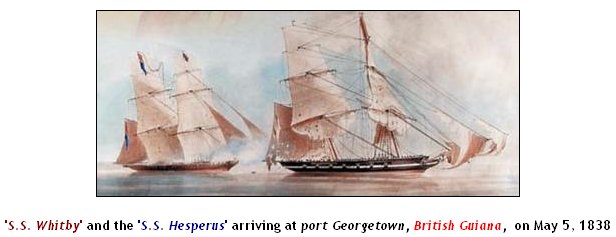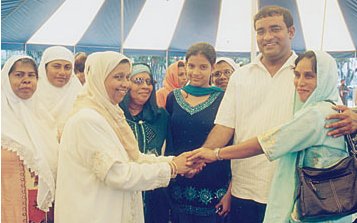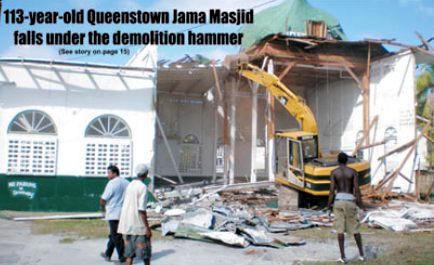Our ancestors
were from a rich
civilisation
IT’s
the Indian
Arrival Day celebration in Guyana and recollections
of the Muslims who came in 1838, jumps on memory lane. You heard
about Fullaman and wondered why Muslims in this land of many
waters are referred to so, sometimes derogatorily. The fact is the
Indians were preceded by Africans, whose main roots were not only
of the Fulla tribe but primarily Muslims. In the scheme of things,
colonialism infamous divide and rule policy made the new Indian
indentures the legitimate Muslims and the old slaves –kapar- or
non-Muslims.

Bollywood
star - Maine Kiya Tumsay Pyaar
Having
lived in India I got the distinct feel that no matter what kurta
you wear and which qaseeda you sing you are an outsider. However,
the continued yearning to know one’s roots never ceases, apart
from Bollywood
desires!

Among
the first batch that arrived on the Whitby
were 94 Musalman, enriched with their Mughal culture-
Urdu language, Persian cuisine, art of reciting Gazals and the
Holy Quran and experts artisans. Learned men among these Asian
tigers appeared, even in the second batch, aboard
the Hesperus, who maintained their Faith, despite the
brutal policies of the Gora- white slave masters.
Interestingly,
I was fortunate in my three years of roots-searching-escapades in
the 1980’s, during my student days, to travel in some of the
areas our ancestors originated from- Lucknow, Ghazipur, Allahabad,
Agra, Gorakpur, Murshidabad, Azamgarh, Mirzapur, Shahabad,
Sultanpur, Faizabad, Patna and Alighar. As I started speaking
Urdu, one gentleman actually commented that my accent smells of a
Ghaziabad background! One friend from Guyana was lucky to have
correspondence with his returned great grandfather and found them
in Azamgarh. I later travelled in Ramadan to their home to have
breakfast with cold sherbet and learn of their Shia heritage. The
Two Eids were well celebrated in Guyana as well as Youman Nabi,
but the Tazia ceremonies that happened until the late 1960’s was
evidence that the Muslims that came were from both Sunni and Shia
traditions, except that division did not survive.

President Bharrat Jagdeo
addressed more than 400 Muslims at a post-Ramadan luncheon and
interactive session at State House.
I
must say that the diligence the mosques and madressa provided in
educating the growing Muslim masses from since 150 years, have
been the key of this community’s establishment.
While
the conversion to Christianity was no easy feat, with converts
gaining the better jobs and educational opportunities, those who
remain steadfast to their dharma were better off, eventually, as
they too did business, went to school and travelled but with self
dignity and “coolie” pride.
The
first mosque stands at Vergenogen as an emblem that the Muslims
built their wooden structure for prayer and while their is a
monument representing that history on the West Coast of Demerara,
the fulfillment of the rebuilt mosque is still to be done. As a
matter of fact the next early mosque at No. 78 Corentyne, still
stands; renovated and active, another symbol that early Muslims
were accustomed to being community oriented as they had already
lived that experience as a Minority in India during the British
Raj.
Recently
a famous gentleman passed away in Pakistan whose domicile was
Toronto for many years. Many heard the name Queenstown
Masjid in his eulogy only
because his wife’s grandfather is buried in the capital’s
landmark mosque- he being an Afghan Pathan who along with others
built that early structure.

Pix
taken from
Kaieteur News,
Saturday,
February 10, 2007
It
was a British sailor that remarked upon seeing the first mosque
facing West that the Kabba in Arabia is positioned East from
Guyana, moreso Northern, and not West as the case in India.
Muslims
joined their counterparts of the African community as speakers of
Arabic and while the return to Islam by then was slow and painful,
over the years that understanding and solidarity have grown,
giving obvious optics that these two communities can naturally
co-exist.
With
several rebellions marking the sore sojourn of Indian arrival in
Guyana and fatal quest for freedom being etched on their altar of
pride- the call for same was being reechoed every where and India
itself was ablaze in this self determination struggle. Maybe it
was the harmony around the fire in the logies, reciting Hanoman
Chalisa and Milad Akbar that made the winds of courage raged. Such
has been the pride of Guyana- that Hindus and Muslims are seen as
Bhai-Bhai until this hour.
According
to Raymond
Chickrie: Hindustani Muslims in Guyana have had a
long history of resistance dating back to October 11,1838, when
two Muslims – Jummun (Juman) and Pultun escaped the clutches of
the gora sahibs (white masters). The bodies of two strange men
were discovered shortly afterwards at Mahaica, in the bushes who
were believed to be the two “runaway coolies” Jummun and
Pultun. We also saw the Rosehall uprising of 1913 where mainly
Muslims were at the forefront “battling” imperialism - Moula
Bux, Jahangir Khan, Dildar Khan, Chotey Khan, Aladi, and Amirbaksh
stood up to the injustices on the plantations.
Others
were named in West Coast Demerara and those who joined other
leaders in the forefront as workers union activists, etc. Later in
politics and parliament and until today in business and all fronts
of life those names resound, although at times the names do not
necessarily denote Islam.
When
you compare today’s migration to North America by Indians from
Guyana, you see the parlance of a better life, however a reality
or delusion that maybe. Calcutta in those days stood as the
recruiting ports for laborers with gold and land as the prize.
That a child may see an abundant opportunity of education and well
being, parents leave their comfortable abodes and migrated away
from Guyana. There too they have maintained a strong semblance of
community and faith, while enjoying the new citizenship of giving
and respect of diversity.
Maybe
its time that the remittance and the reputation be held for once
and the question asked- if we love foreign things so much, how
about also accepting some foreign ideas of religion that will make
the social life much more rewarding and the spiritual much more
alluring – as much as Western Union and US TV does for those
living faraway from loved ones.
Indian
Arrival Day may present its issues but for once, just for once, to
remember that we did not just appear from nowhere but our
ancestors were children of a rich civilisation somewhere in Asia
that boasts of culture, arts, languages, armies, wealth, histories
and values, today the world is so proud of.
HABEEB ALLI
His
website
Thursday, May
21, 2009